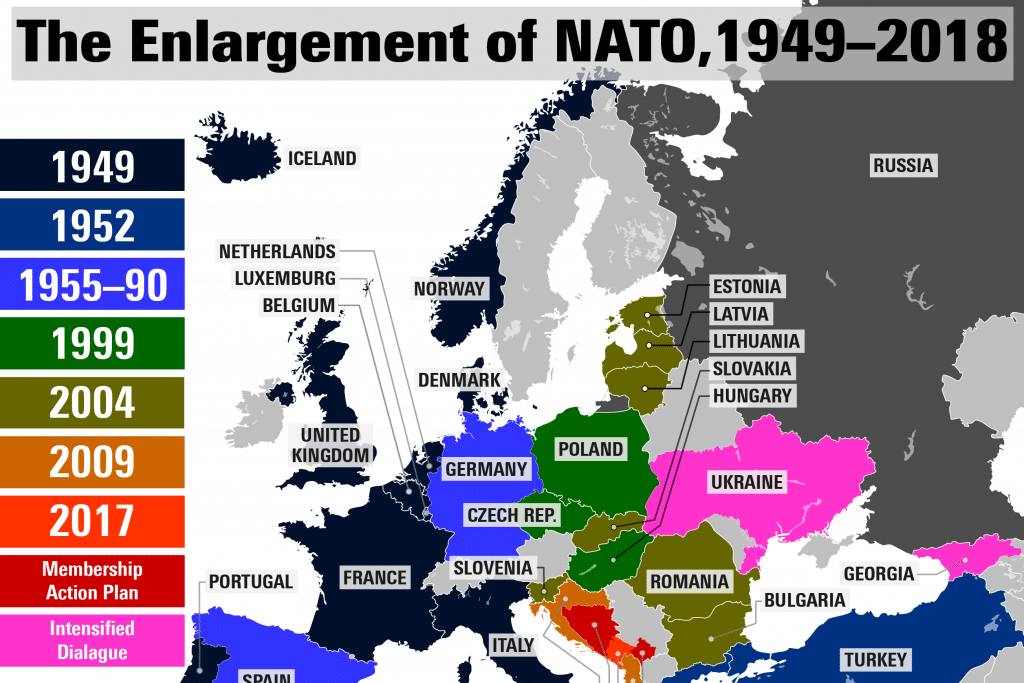
How NATO Went Rogue
Tomasz Pierscionek / Morning Star
LONDON (August 9, 2024) — To mark the 75th anniversary of NATO’s creation, veteran anti-war activists Medea Benjamin and David Swanson have published a book that explores the alliance’s origins and critiques its role in global affairs over the past several decades.
The authors produce a much-needed antidote to the pervasive propaganda that claims NATO makes the world a safer place.
Benjamin and Swanson duly set the record straight and offer a powerful riposte to the arguments upon which NATO’s proponents rely in order to justify the military collective’s long overdue existence.
NATO’s first secretary-general allegedly declared that the organisation, originally comprising 12 members when founded in 1949, aimed “to keep the Soviet Union out, the Americans in, and the Germans down.” Notwithstanding this comment’s facetiousness, the words hold a darker meaning and provide an insight into what NATO would become.
Taking NATO’s founding document (the Washington Treaty) at face value, its original members sought collectively to preserve stability within the North Atlantic region while adhering to the principles of the United Nations Charter, desiring to live in peace with all nations, and seeking to resolve any disputes peacefully.

We learn that in the ensuing decades, NATO would expand its influence far beyond the North Atlantic area, incorporate countries which were dictatorships at the time (such as Greece and Turkey), support colonialism in Africa, seek to thwart democracy by stifling popular communist and left-wing movements across Europe, and support numerous unsavoury groups such as Kosovan criminals and Islamic terrorists.
Benjamin and Swanson thus show how NATO’s future actions would violate the intentions expressed in its founding document.
We learn too how the USSR, fearful of West German rearmament and having recently lost 27 million of its people, asked to join NATO in the mid-1950s with the intention of being part of the post-war security architecture in Europe. The request was rebuffed, leading to the USSR forming its own defensive Warsaw Pact the following year.
The reader is left to ponder how different history could have been and which future conflicts may have been avoided had NATO’s founders accepted this offer of detente during the cold war’s early years. Perhaps it is not coincidental that NATO’s first military operation only occurred after the USSR’s collapse, when it became engaged in shooting down Serbian planes during the Bosnian war of the mid-1990s.
Subsequent chapters reveal how NATO became a vehicle for the US to pursue its dreams of global dominance without the shackles of international treaties or the Constitution. For example, whereas the president of the United States requires Congressional approval to undertake military action, this constraint is not required for the US-led NATO alliance to go to war.

Benjamin and Swanson discuss the role NATO has played in the Yugoslav, Afghan, Iraq and Libyan conflicts to demonstrate how the military bloc leaves a trail of destruction and chaos in its wake, a far cry from the stability and democracy it claims to uphold.
The alliance has also morphed into an excuse to oblige member nations as well as non-member countries (the latter referred to as NATO’s “global partners”) to purchase US-made weapons under the guise of promoting “inter-operability.”
Voicing the opinion that Ukraine joining NATO is a ludicrous idea that will provoke an aggressive response from Russia may nowadays get you demonised as promoting pro-Kremlin propaganda. Yet Benjamin and Swanson tell us that such a view was considered sensible in the upper echelons of US politics not too long ago.
For example, former US ambassador to Moscow William Burns reportedly once sent a communique back home explaining that Ukraine joining NATO would be “the brightest of all red lines for the Russian elite (not just Putin),” adding that this was a view shared by President Putin’s harshest critics and that “I have yet to find anyone who views Ukraine in NATO as anything other than a direct challenge to Russian interests.”
Ironically, as the authors describe, Russia’s invasion of Ukraine gave NATO a new lease on life at a time when some politicians were beginning to question the organisation’s purpose. While rightly condemning the invasion, Benjamin and Swanson explain how relentless expansion and provocation from a US-led NATO over the preceding two decades set the scene for a war that could have been avoided.

How Afghanistan became a NATO war.
I was left wondering how Western nations would have reacted to Russian encroachment after the Cold War had roles been reversed. Relabeling the acronym NATO as Not A Tenable Option, Benjamin and Swanson finish by describing alternatives to the alliance that could de-escalate tensions around the globe while providing countries with a sense of security.
The authors present their case in a clear and straightforward manner that makes their analysis easy to comprehend. Despite being less than 150 pages long, NATO: What You Need to Know contains a plethora of vital wisdom for readers across the political spectrum.
Its publication comes at a time when many, including some on the left or those once considered as anti-war, have been seduced into swallowing militarist propaganda that advocates arming Ukraine to fight Russia regardless of what consequences may transpire.
The world is closer to witnessing a conflict between nuclear-armed powers than it has been for decades. Now is the time to change direction before it is too late.
Recommended:
NATO: What You Need to Know by Medea Benjamin and David Swanson, OR books.